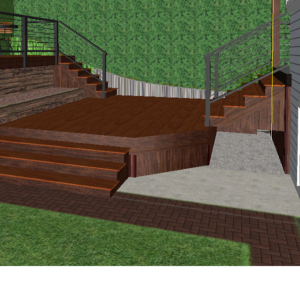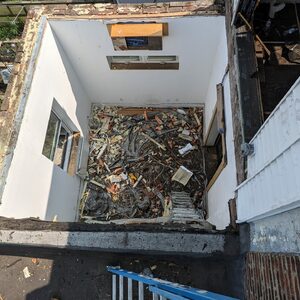In this FHB build, they used Cumaru. Was board cupping a concern? I am building a similar deck in Vancouver BC, a fairly wet climate and though I would prefer wood, I am told cupping could occur. To minimize cupping, I am considering using 5/4 x 4 face fastened, or going composite.
Any thoughts? Is it possible to contact the buiilder on the project deck?
My concept.





















Replies
drainage and gravel are your friends
I was one of the two guys doing this build with Cumar. It's best to think about cupping as a function of under deck moisture, not one species of wood vs. another. You need to make sure you have good drainage and ventilation. For decks with skirts, like this one, ventilation is less helpful, so it's essential to put down a layer of coarse gravel, which acts as a capillary break, preventing groundwater from leaching up towards the underside of the deck.
Here's a relevant snippet of text from the article on this build:
The basics of moisture control are simple: Start by sloping the ground for drainage; you don’t want water to settle under your deck. After that, put down several inches of gravel. moisture wicks up to the surface through soil by capillary action, which only works when water can go from larger pores to smaller ones. Such a path is found easily in soil. Gravel creates a layer of larger pores that short-circuits capillary action, helping to keep the moisture in the soil and away from the deck. Landscape fabric below the gravel keeps dirt out and weeds from sprouting. Finally, never let any part of the deck frame touch the ground.
Full article can be found here: https://www.finehomebuilding.com/2015/01/07/framing-a-grade-level-deck
Hope that helps!
drainage and gravel are your friends
Thanks for getting back on this. I really appreciate the help.
In my case, I'm building directly over the existing surface which is about 50% concrete slab, 30% brick pavers over sand, and 20% open soil at the base of a retaining wall and everything slopes to the base of this retaining wall.
Does the gravel still provide the necessary break?
cupping results from moisture and sunlight
Please save the Brazilian forests!
In my experience cupping occurs most often because the deck board is subjected to moist underneath (evaporating, moist air from the ground) and direct sunlight from above. Cupping is not so much related to moisture alone. If you are skeptical, lay a treated SYP board in a pond and see what happens :) Cedar decking is less likely to warp and crack than treated lumber, but it does not last as long. If you use cedar be sure to seal edges, faces and ends.
Be sure there is good ventillation below the deck.
Personally, I don't find composite boards very attractive. They appear too "fake, too "plastic", in my opinion. Expansion and contraction forces can lead to gaps at mitred joints.
Natural wood decks in shaded areas or in areas where sunshine is limited, tend to encourage the growth of mildrew. An accasional wash may be required.
Face fastened (true wood) boards are less likely to cup than blind-fastened boards...but they may split. If you face fasten, be sure the screw head is of a sufficient size (do not use finish screws). Ringshank nails may also be considered. Finally, keep joist spacing to max 16" oc..
Mel froscarpentry.com
Ironic timing. We built a fairly large Cumuru deck about 9 months ago. I had to go by today to take photos for a warrenty claim against the supplier. No cupping but many of the boards have cracks along the edges and splits all over the middle. I've never seen wood check like this and it's in the shade most of the time. Both the customer and I wish she had spent a little more and used Ipe. The Cumuru looks terrible.
Deck boards splitting
Just ot of interest, is this deck similar to mine? I'm building just 24" above grade and in quite a moist climate, albeit colder than Florida's. The deck will also be completely enclosed, virtually no air flow.
Homeowner, handyman. I often do a job once, enough to learn what not to do, but seldom a chance to put that knowledge to work.
The deck is on Fort Myers Beach so lots of moisture. It is about 8' off the ground with sand underneath. I will not be using Cumuru again. I went by again yesterday, moved all the furniture, took another look and found it even worse than the day before. It'ds very depressing for several reasons. The customers are unhappy and I'm going to have to devote a lot of labor toward replacing the boards.
Found this online:
Here in Peru Cumaru is called Shihuahuaco and as you say it is sold in the States as Brazilian Teak. It has nothing to do with teak, just a marketing name.
It leaves the Amazon as decking and flooring. These guys that sell this kind of stuff on ebay with the fake names and dont explain what the wood really is should be hung. I´m sure many people buy this thinking it was plantation teak and when the peice of rock arrives that is virtually unworkable the .99 price was quite high. Another is Santos Mahogany, this also is like stone and has nothing to due with Mahogany. I´ve even seen African Purpleheart on ebay, now that would be a suprise to the scientific community.
The thick decking stock is virtually never completly kiln dried as for 5/4 stock to dry to 6-8% moisture content it would take at least 60 days in the kiln and would not be economicly reasonable. It is usually taken down to about 20 - 30 % for decking and the 3/4 for flooring is dried to 8%. I have used it for floors in both houses and boats and had no problem with polyurethane sticking perfectly. I have never noticed an oil problem.
I'm not clear on how your deck will be installed over a combination of a concrete slab and pavers over sand, but assuming the structural part is handled appropriately with frost-depth footings and all, then your concern becomes positive drainage to daylight. If water is going to flow and then settle by that retaining wall then I'd make sure it has a way to get from that wall to the open air so it's not hanging out under the deck. As for the question of whether gravel will still help, the principle we're talking about here, the porosity of gravel vs. sand/concrete/whatever below it will always help. In your case I'd also be considering a membrane of some kind to keep moisture from coming up through all that masonry. If you use a membrane, make sure it won't just become a swimming pool, that's the key. Stopping water vapor from coming up = good, giving water a place to pool and hang out = bad.